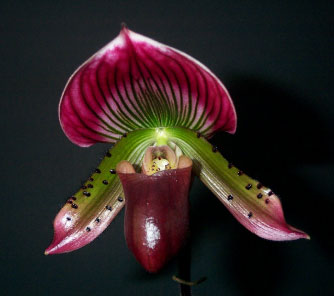Showy lady slipper - Cypripedium reginae - flower opening
The showy lady slipper (Cypripedium reginae), also known as the pink-and-white lady slipper or the queen's lady slipper, is a rare orchid found in eastern North America. The plant became the state flower of Minnesota in 1902, and it became protected by state law in 1925. It is illegal to pick or uproot a showy lady slipper flower in Minnesota. This rare plant has vanished from much of its historical range due to habitat loss.
Found in damp woods, bogs, and swamps, the orchid can take 16 years to grow and bloom for the first time. The plants can live for 50 years, and tend to flower in late June and early July. Usually, there are one or two flowers per stem, but there can be three or four. The stem has a hairy appearance, and the "hairs" can cause irritation to some people.
Although this plant was originally chosen as the provincial flower for Prince Edward Island in 1947, it was so rare on the island that another Lady's Slipper, C. acaule (moccasin flower or pink lady slipper), has replaced it as the province's floral emblem.
Cypripedium reginae can be found in Canada from Saskatchewan east to Atlantic Canada, and the eastern United States south to Arkansas and Tennessee.
--------------------------------------
This flower is quite rare, and is considered imperiled (SRANK S2) or critically imperiled (S1) in Arkansas, Connecticut, Illinois, Iowa, Missouri, New Brunswick, New Hampshire, New Jersey, Newfoundland and Labrador, North Dakota, Nova Scotia, Ohio, Pennsylvania, Prince Edward Island, Saskatchewan, Tennessee, Virginia and West Virginia. Additionally, it is considered vulnerable (S3) in Indiana, Maine, Manitoba, Massachusetts, New York, Quebec, Vermont, Minnesota, and Wisconsin.
It was historically found in Kentucky and North Carolina, but has not been found recently. The only province to rank C. reginae as apparently secure (S4) is Ontario.
Showy lady's-slipper is quite sensitive to hydrologic disturbances, and is threatened by wetland draining, habitat destruction and horticultural collectors.





Đăng nhận xét